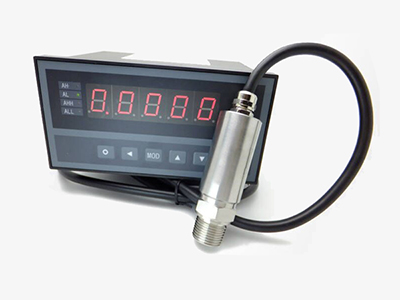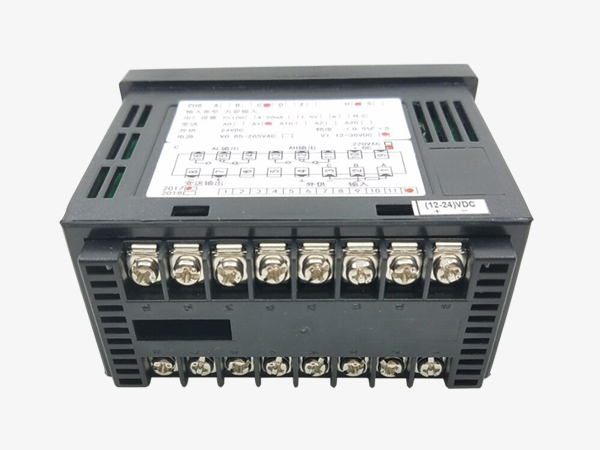Intelligent digital panel meter with 5 digit LED display for potentiometers. It has adjustment and digital filtering function. Digital display controller can help to reduce errors of the sensor and the transmitter, effectively improve the system measurement accuracy and control accuracy.

Display panel meter
- 5 digit digital panel meter can be easily connected with any electronic ruler, and it is convenient and intuitive to display the displacement distance value.
- Display decimal position can be set, with upper and lower limit alarm function. And the number of alarm points can be increased.

Multi-function digital panel meter
- sisco 5 digit digital panel meter has the functions of adjustment, digital filtering and zero reset at any position. The error is less than 0.5%F.S.
- Digital panel meter is suitable for standard voltage, current, RTD, thermocouple and other signal types.
- It comes with transmission output, which can output the measured and transformed display values in the form of standard current and voltage for use by other devices.
Applications
5 digit digital panel meter can be applied to many occasions, including petrochemical, mechanical shipbuilding, plastic machinery, light industry machinery, chemical, metallurgy, electricity manufacturing, food, medicine, etc.

| Basics | Model | SISCO-DPM5 |
| Dimension | A 160*80*125mm horizontal, hole size 152*76; B 96*96*112mm, hole size 92*92; C 96*48*112mm horizontal, hole size 92*45. |
|
| Shipping weight | 2 kg | |
| Technical parameters | Display | -19999~99999 |
| Measurement accuracy | 0.05% | |
| Measuring speed | 10 times/second | |
| Display method | 5 digit LED display | |
| Instrument power supply | 100-240VAC, 50/60Hz; 10-24VDC | |
| Input signal | DC current 4-20mA, 0-20mA, 0-10mA; DC voltage 0-5v; DC voltage 0-10V; Signal of mV; Potentiometer (500Ω-20KΩ). | |
| Contact input (optional) | External switch input for clearing | |
| Alarm (4 kinds can be Selected) | J0(no alarm), J1-J4 (1-4 kinds), J3 and J4 just for dimension A, B | |
| Transmission (optional) | B0 no output; B1 current output (4-20mA), (0-10mA), (0-20mA); B2 voltage output (0-5V), (1-5V); B3 voltage output (0-10V). |
|
| External power supply (optional) | W0 no power; W1 24V DC; W2 12V DC; W3 10V precision power supply. |
|
| Communication (optional) | T1 TC ASCII protocol RS232; T2 TC ASCII protocol RS485; T3 Modbus-RTU protocol RS232; T4 Modbus-RTU protocol RS485. |
|
| Print function (optional) |
Note: The optional functions are not necessary, can be selected according to your need. Communication and transmission can't be compatible at the same time.
Q1: What is a digital panel meter?
A1: The digital panel meter displays the voltage, current value or other standard signal transmission display value in the electrical circuit by digital direct reading; the product has the advantages of good stability, strong anti-interference, high cost performance, and the product is small in size and can be directly replaced original pointer meter.
Q2: What are the functions of digital panel meters?
A2: Digital panel meters can be categorized by type, size, style or other criteria. Understanding the functions of the digital panel meter is an important factor in choosing it. Commonly used functions are ammeters, voltmeters, frequency meters, power meters, energy meters, counters, timers, thermometers, process meters and controllers.
Q3: What are the advantages of digital panel meters?
A3: The digital panel meter directly displays the measured value or deviation value by digital quantity, which is clear and intuitive, easy to read, and will not produce parallax. Digital panel meters generally use large and medium-scale integrated circuits, with simple circuits, good reliability and good shock resistance. Because of the common modular design method for instruments, that is, digital panel meters are mostly composed of a small number of modular circuits with separated functions, so they are conducive to manufacturing, debugging and maintenance.
Tips: Why use a digital panel meter?
Digital panel meter is an electronic device that converts signals such as load cells or weight transmitters into digital display of weight, which can store, count and print weight data. It is often used in automatic batching and weighing in industrial and agricultural production to improve production efficiency.
With the development of technology, the digital panel instrument manufacturing industry has introduced microelectronics technology, which greatly improves the predictability and accuracy of the display controller and improves its reliability.
Before use, the digital panel meter should be calibrated with a load cell. Calibration is the calibration of the display controller with standard weights. The calibration coefficients relative to this set of sensors are stored in the calibration instrument. With these coefficients, the panel meter can convert the load cell's analog signal into a digital weight display.
Thank you for buying industrial test and measurement equipment on SISCO.com, all products sold by SISCO and the partner cover a 12 months warranty, effective from the date of receiving the products.
What is covered?
SISCO is responsible for providing free spare parts, and free technical support to assist the customer to repair the defective products until the problem is solved.
What is not covered?
- Product purchased from anyone other than a SISCO store or a SISCO authorized reseller.
- Expendable parts.
- Routine cleaning or normal cosmetic and mechanical wear.
- Damage from misuse, abuse or neglect.
- Damage from use of parts other than SISCO approved.
- Damage from use outside the product’s usage or storage parameters.
- Damage from use of parts not sold by SISCO.
- Damage from modification or incorporation into other products.
- Damage from repair or replacement of warranted parts by a service provider other than a SISCO authorized service provider.
- Damage caused by the application environment not meeting the product usage requirements and the failure to perform preventive maintenance.

